THE KINGDOM OF THE THREE POWERS AND THEIR ASSOCIATES IN SAMOA:
By the late 1880’s it had become clear to the Samoans that whichever party was to be recognized as the Malo must control the succession to the throne. The Papa titles of the Tafa’ifa could be claimed as a prize in war, but national recognition of the titular supremacy signified by the tafa’ifa required all four titles to be bestowed by the Fale-Upolu (Group of tulafale, in this case Tumua and Alataua) of Atua, A’ana and Tuamasaga with a high degree of consensus and common interest. The Samoan conception of a supreme ruler or King. (O le Tupu) referred to the head of a victorious party which ruled by conquest. Such a leadership required the maintenance of control by force, an impossible goal in Samoa since the 1860’s, when European gun boats had given the settlers a balance of power they could exercise to bring down any Samoan Malo.
The massive land claims being made by the settlers might have united the Samoans had demands been made by a single foreign group, but the problem was that resolution of conflicting land claims would satisfy one interest group, but not another. The same was true of the Samoans – any resolution of claims in favour of a particular foreign interest group would mean that some Samoans would lose great amounts of land while others would have their land rights upheld. Therefore the individual interests of each nu’u and sub-district, and of individual matai in many cases, became linked to the support of particular settler factions.
Having won the latest war and seen their German allies deport Malietoa, Tamasese’s supporters declared him tupu and tafa’ifa (although he held only one of the papa, Tuia’ana). The declaration was interpreted by Samoans and settlers alike as a declaration of German supremacy in Samoa, and opposition to it coalesced around Tuiatua Mata’afa Iosefo. In the absence of Malietoa Laupepa, some of the branches of the Sa-Malietoa had conferred the Malietoa title upon Mata’afa; thus his network of family connections covered most districts in Samoa. Mata’afa’s one political liability was that he was Roman Catholic in a predominantly Protestant land. However, as a focus for anti-German feeling, he received supporters. Once again the elaborate political negotiation to raise any army began.
War broke out in 1888 but unlike previous wars, settlers and their property were targets on both sides. The consuls sent for naval reinforcements and in 1889 seven warships were anchored off Apia. Their involvement was cut short by a hurricane which sent six of the ships, three Americans and three German, to the bottom of the sea with a loss of 155 foreign lives. Mata’afa’s side won the war but, ironically, at the very time he was being hailed as tupu by most of Samoa, the three powers declared Malietoa Laupepa to be King by the terms of the Berlin Act to which all three were signatories. The decision was foolish because it took no account of the realities of the situation in Samoa. The Germans would not accept Mata’afa because he had brought about the defeat of their supporters. The British and Americans took the view that Tamasese was a German puppet. Malietoa was a compromise choice for the three powers but not for the Samoans. When he was brought back to Samoa in 1889, he at first recognized the Mata’afa victory and his right to be tupu. The condominium established by the Berlin Act had not been put into effect but Malietoa was soon persuaded to accept the office that the foreign powers offered him by their recognition on paper. The problem was to obtain Samoan acknowledgment of his right to be King. Accordingly Malietoa’s supporters began to raise any army so as to make his government legitimate by defeating Mata’afa in war.
“The case for Malietoa asserted that he held the four papa titles and was tafa’ifa, Lauaki Namalau’ulu Mamoe of Safotulafai in Savaii, asserted that Malietoa had no such recognition. He claimed that Malietoa held none of the titles, not even that of Malietoa, since none had been bestowed by Samoan custom. In this contention Lauaki was supported by the Orators of Malie and Manono.”
Namalau’ulu Lauaki Mamoe: A great Samoan hero and his loyalty to Samoan Customs. He never made it back to Samoa from here.
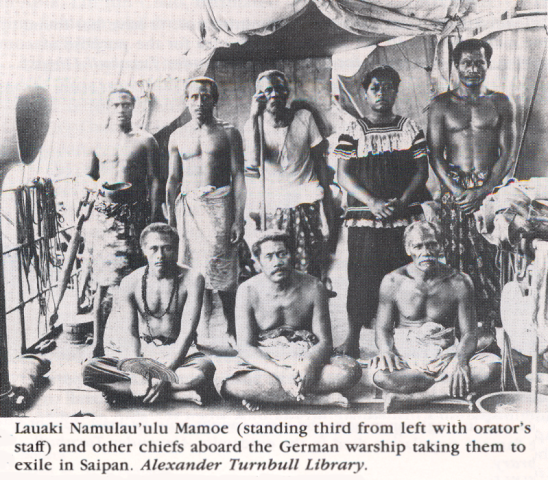
Then another tradition says that from 1810 the most powerful chief was Tamafaiga of Manono who gave himself the title as ‘Tupu o Salafai’. According to this tradition the only person to hold the Tafa’ifa since Salamasina was Fonoti who was known as Fonoti the King!
 In 1912, One of the changes, the German administration had apparently achieved its long-term objectives of understanding the traditional forces in Samoa politics, while maintaining a semblance of local participation in government. There was no more TUPU, nor even ALI’I SILI, but the two Fautua were appointed. Tumua and Pule were for a time silenced, all decisions on matters affecting lands and titles were under the control of the Governor. To complete the process, the Fa’alupega for all Samoa was revised. The Fa’alupega which had been nationally accepted from at least the late 19th century (and probably for much longer than that) was as follows:
In 1912, One of the changes, the German administration had apparently achieved its long-term objectives of understanding the traditional forces in Samoa politics, while maintaining a semblance of local participation in government. There was no more TUPU, nor even ALI’I SILI, but the two Fautua were appointed. Tumua and Pule were for a time silenced, all decisions on matters affecting lands and titles were under the control of the Governor. To complete the process, the Fa’alupega for all Samoa was revised. The Fa’alupega which had been nationally accepted from at least the late 19th century (and probably for much longer than that) was as follows:
“Tulouna a Tumua ma Pule,
Tulouna a Itu’au ma Alataua,
Tulouna a Aiga-i-le-Tai,
Ma le Va’a-o-Fonoti.”
(exclude the new addition below as at current)
Tulouna a Tama ma a latou aiga,
Po’o aiga ma a latou tama.
This Fa’alupega firstly recognized the authority and identity of principal districts of Samoa through their spokesmen –Tumua ma Pule, Itu’au ma Alataua, Aiga I le Tai, ma le Va’a o Fonoti – and the highest titles which were bestowed by these groups. It concludes with the recognition of the great maximal descent groups of Samoa and their ’sons’ who had been chosen to hold the highest titles.
The new Fa’alupega of German Samoa apparently required for Malietoa Tanunafili and Tupua Tamasese to be sworn on oath and to change this Samoa’s historical Fa’alupega to the new fa’alupega as follows:
“Tulouna a lana Maiesitete le Kaisa o le tupu mamalu o lo tatou malo kasialika aoao.
Tulouna a lana afioga le kovana kasialika o le sui o le kaisa I Samoa nei.
Susu mai Malietoa, Afio mai Tupua
Ua fa’amanatuiana ai aiga e lua I o oulua tofiga Kasialika o le Fautua.
Tulouna a le vasega a Faipule Kasialika o e lagolago malosi I le Malo.
Afifio mai le nofo a vasega o tofiga Kasialika o e usu fita I le tautua I le malo.”
“Aiga e lua” referring here to the two fautuas Malietoa and Tupua is a classic example of the changes to the original Samoa that got carried through by New Zealand period of ruling Samoa right down to this present time.
“Aiga E Lua” o Samoa, the Two Main Families of Samoa: Le Aiga Pa’ia O Sa-Levalasi, and Aiga Fa’alagilagi Le Aiga Sa-Tuala. Aiga fa’avae ma le faitaulia a ia e lua o lo’o ta’oto ai gafa Tautupu ma gafa Tautamali’i o Samoa.
FOOTNOTES RECORDED BY HISTORIANS:
On May 3, 1841, Malietoa Vai’inupo (”Tavita”), the first tama ‘aiga chief to accept Christianity, died in Western Samoa. (1e. Theroux 1985)
On February 25, 1868, Malietoa Laupepa was proclaimed “King” of Samoa. The French reported that the proclamation was inspired by Consul J.C. Williams. (1a. Morrell 1960: 213)
On February 7, 1876, Malietoa Laupepa, appointed as “King of Samoa” by the Three Consuls and held aboard HMS Barracouta, was persuaded to sign a letter requesting the arrest of Samoa’s “Premier” Albert Barnes Steinberger as “a liar and an impostor.” (1a. Morrell 1960: 218)
On December 23, 1879, German warships saluted Malietoa Talavou and the new Samoan flag, which was red with a white cross and a white star in the upper left quadrant. (1e. Theroux 1985)
On March 12, 1880, Malietoa Talavou was declared “King of Samoa” and his nephew, Malietoa Laupepa was declared “Vice King,” to succeed his uncle on his death, by the Three Consuls (Britain, Germany and the United States). (1a. Bryan 1927: 27)
On March 24, 1880, in Apia, an agreement was entered into by “King” Malietoa Talavou, the Government of Samoa and the “Three Consuls” (Britain, Germany and the United States) whereby the Consuls agreed to support the King, and to provide an Executive Council for him. The members of the council were Thomas Trood, English, Minister of Finance; Alfred Volkmann, German, Minister of Public Works and Jonas M. Coe, American, Minister of Justice. (Jonas Coe was the father of Emma Eliza Coe, the legendary “Queen Emma”). (1d. Bryan 1927: 27)
On March 10, 1881, Malietoa Laupepa was crowned “King of Samoa” by the “Three Consuls” (Britain, Germany and the United States). (1d. Bryan 1927: 27)
On March 19, 1881, Malietoa Laupepa, nephew of the recently deceased Talavou, was declared “King of Samoa” by the “Three Consuls” (Britain, Germany and the United States). Tupua Tamasese Lealofi I and Mata’afa Iosefo opposed the declaration. (1d. Bryan 1927: 27)
On April 21, 1881, Tupua Tamasese Lealofi I, Mata’afa Iosefo and other disaffected chiefs met at Leulumoega, ‘Upolu. Tamasese was declared “King” of Atua and A’ana districts, to hold office for two years, and then to be succeeded by Mata’afa. (1d. Bryan 1927: 27)
On July 12, 1881, the “Lackawanna Agreement,” mediated by Captain J.H. Gillis of the U.S. Navy, commanding USS Lackawanna, was signed in Western Samoa, dividing kingly honors between “King” Malietoa Laupepa and “Vice King” Tui A’ana Tupua Tamasese Titimaea. (1a. Gray 1960: 68-69)
On December 31, 1885, in Apia, the German Consul in Apia, Dr. C. Stuebel, hauled Malietoa Laupepa’s flag down, explaining that Malietoa had no jurisdiction over the municipal zone. (1a. Gilson 1970: 379, 381)
On August 27, 1887, German warships distributed declarations of Tui A’ana Tupua Tamasese Titimaea’s war on Malietoa Laupepa (which lasted until September 1, 1887. (1a. Gray 1960: 78)
On September 15, 1887, Captain Eugen Brandeis, a German officer, forced Malietoa Laupepa and other chiefs to sign a document declaring Tui A’ana Tupua Tamasese Titimaea as “King of Samoa.” (1a. Gray 1960: 78-79)
On September 5, 1888, the German warship SMS Adler (”Eagle”) shelled Manono and Apolima, which were strongholds of Malietoa’s forces. (1a. Gray 1960: 83)
On March 23, 1889, Malietoa Tanumafili I was installed as “King of Samoa” by the “Three Consuls.” (1a. Gray 1960: 99)
On June 14, 1889, the Berlin General Act proclaimed the “independence and neutrality of the Samoan Islands” and provided for the recognition of Malietoa Laupepa as “King.” Another aim of this Act was “to avoid all occasions of dissensions between their respective and the people of Samoa” while at the same time “promoting as far as possible the peaceful and orderly civilization of the people.” (1a. Kennedy 1974: 96-98; 1d. Coleman 1959: 7)
On December 5, 1894, the Samoan Land Claims Commission held its last meeting, awarding 75,000 acres to German claimants, 36,000 to English petitioners, and 21,000 to American hopefuls. (1a. Gilson 1970: 411; 1a. Gray 1960: 97-98)
On November 15, 1898, after a great fono in Mulinu’u, Mata’afa Iosefo was declared “King.” This news was relayed to the Three Consuls and the Chief Justice. The Germans supported his claim, but Malietoa Tanumafili I and Tui A’ana Tupua Tamasese Lealofi I denied the legality of the election. Chief Justice William Lea Chambers agreed with them, and civil war once again erupted. (1a. Gilson 1970: 426-427).
On December 31, 1898, in accordance with the provisions of the Berlin General Act, the Chief Justice of Samoa ruled that Malietoa Tanumafili I would be “King,” as the three claimants (Malietoa, Tui A’ana Tupua Tamasese Lealofi I and Mata’afa Iosefo) could not agree among themselves as to who should be “King.” Once again, civil war broke out. (1d. Bryan 1927: 40)
On January 4, 1899, The “Three Consuls” (of England, Germany and the United States) recognized Mata’afa Iosefo’s government in Apia. (1e. Theroux 1985)
On March 31, 1899, Mata’afa Iosefo’s forces defeated Malietoa Tanumafili’s army in yet another phase of Samoa’s ongoing, European-inspired civil war. (1a. Gray 1960: 101)
On March 1, 1900, Dr. Wilhelm Heinrich Solf, newly appointed as Imperial Governor of German Samoa (called “Deutsch Samoa” or simply “Samoa” by the Germans), raised the flag at Mulinuu, Apia “in the presence of a great audience. The Kaiser’s proclamation, read at the ceremony, stated: ‘We hereby, in the name of the Empire, take these islands under our Imperial protection.’ The Governor declared the islands to be German territory, and hoisted the Imperial flag of the Consulate to the strains of ‘Heil Kaiser, Dir,’ [‘Hail to you, Emperor’] and a national salute from H.I.G.M.S. [His Imperial German Majesty’s Ship] Cormoran and the U.S.S. Abarenda, Commander B.F. Tilley, United States Navy, Commanding. Governor Solf visited Abarenda the next day and was saluted with 13 guns.” (1d. Bryan 1927: 43; 1a. Field 1984: 26)
On March 9, 1900, Mata’afa Iosefo thanked the German Emperor (Kaiser Wilhelm II) for taking possession of the western Samoan islands, and expressed his wish that the German colonial laws would be made “in conformity to the rules and customs of the Samoans.” (1a. Hempenstall 1978: 33)
On September 16, 1901, Dr. Wilhelm Heinrich Solf, Governor of German Samoa, issued a proclamation which forbade the Samoan custom of fa’atafea (banishment of wrong doers). The proclamation closed with this statement: “This is my word; everyone must obey it.” (1b. Theroux 1983b: 55)
On February 18, 1903, German Samoa’s Governor, Dr. Wilhelm Heinrich Solf, proclaimed the establishment of a Land and Titles Commission. (1a. Davidson 1967: 81)
On June 21, 1913, Following the decree from the German Emperor that the Governor may select one member of the Tupua family and one member of the Malietoa family to be his trusted friends and advisers, Tupua Tamasese and Malietoa Tanumafili (i) were sworn in as Fautua. Their remuneration was 2000 Deutschmark per year. (Tom Overhoff: 2009)
On November 14, 1915, Lauaki Namulau’ulu Mamoe, one of the leading orators of his time and a leader of the Mau a Pule, died on Tarawa in the Gilbert Islands. He was en route to Samoa from Saipan in the Mariana Islands, whence he had been exiled by the Germans. (1a. Davidson 1970: 298)
On December 6, 1928, Tupua Tamasese Lealofi III, a leader of Western Samoa’s Mau, was found guilty of a summons relating to the non-payment of a poll tax in 1927, and was sentenced to six weeks in jail. He was also found guilty of resisting arrest, and was sentenced to a six-month jail term in New Zealand. (Field 1984: 131-132)
IT IS OBVIOUS THAT THIS WILL BE WHERE THE CHANGES MADE TO THE ORIGINAL SAMOA FOR THERE OWN BENEFIT OF THE GERMAN GOVERNOR AND THE TWO FAUTUAS! AND ONE THING GOT CHANGED BACK TO ITS ORIGINAL WAS THE ‘ALL OF SAMOA FA’ALUPEGA’, BUT THE REST MAY LIES IN WHAT HAS BEEN WRITTEN AND GIVEN AS SAMOA’S HISTORY TO WHAT IT IS THERE TODAY. WOULD BE THE REASON ALSO WHY THERE ARE MANY CASES ON DIFFERENT VERSIONS TO AN EVENT FROM THE HISTORY OF SAMOA.
Related info from book: Queen Victoria Born to Succeed. By Elizabeth Longford. (Chapter: The Labourers Task: Page 543)
One of the difficulties hardest to bear was the Kaiser’s exultant telegram congratulating President Kruger, who was still supposed to acknowledge the Queen’s suzerainty, on the preservation of his independence. This loaded word produced a howl of rage from millions of British throats, hitherto choked by shame. The Prince of Wales wanted to know what business the Emperor has to send any message at all? He only hoped William would not appear at Cowes this year. (The Kaiser had distinguished himself the year before by picking a quarrel referring to his uncle as the old popinjay, and going home early in a huff).
It was not till 1899 that the Kaiser’s huge white yacht, Hohenzollern, was invited once more to the solent. A dispute which Lord Salisbury over Samoa prevented the visit. Queen Victoria heard that William was ‘vy cross – declared Ld Salibury to be his enemy & that he won’t come to England while he is P.Miniter. She commented drily: ‘I think he will have to wait a long time.’ Three weeks later the Kaiser gave her his own version of the facts: Lord Salisbury had treated Germany in ‘the most unhappy way’ over Samoa – ‘a stupid island which is a hairpin to England compared to the thousands of square miles she is annexing right and left unopposed every year. The hairpin seems to have pricked the conscience of the Queen. She had already observed, apropos of China, that she ‘could not quite understand why nobody was to have anything anywhere but ourselves. Accordingly, she invited the Kaiser to Windsor for the autumn. This visit, the last, was an unexpected success, William being ‘sensible & kind’ and Dona ‘not at all stiff’.
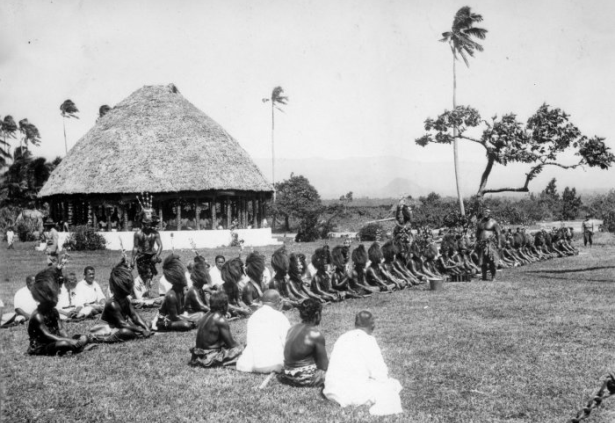
THE KINGDOM OF SAMOA BY SAMOAN CUSTOMS IN THE 1600’S
THE SUCCESSION LINE OF THE ROYAL FAMILY OF SAMOA; One of the early kings was Tuia’ana Tuiatua Faumuina Le Tupufia. He had three children. The sons were named Fonoti and Va’afusuaga Tole’afoa, and the daughter was named Samala’ulu. They are Known commonly in traditions of Samoa as ‘The Three of Faumuina‘. Each child was by a different mother, but Tuia’ana Tuiatua Faumuina before he died, he did not declare a decree for a successor to rule on the throne. And intimately, this is why his three children, Fonoti, Samala’ulu and Va’afusuaga Tole’afoa entered into war to fight it.. the dispute was also taken up by their maternal relations that became so intense that war was raged to who will be King. And began the arise of famous family clans of Samoa such as Sa-Tuala, Sa-Levalasi, Sa-Asomua, Sa-Tago, Sa-Amituana’i, Sa-Tunumafono and others. This is also why their father or the title Faumuina is greeted as ‘Le Tupufia‘. Tupufia, means or referred to of his children that they all wanted to be King! in the 1600’s
Va’afusuaga Tole’afoa and sister Samala’ulu had joined up to opnose the claim of there brother Fonoti to the Tafa’ifa Kingship. When Fonoti found out that his brother and sister had gained many followers, he went to Leulumoega where the dispute was being fought and sought the assistance of the High Chiefs and leading orators of other districts. This was the war that Mano’o of Samatau said before the war: if Fonoti runs into the sea, we will dry up the sea, if he runs into heaven, we will rip it open to catch him. As a result he was pursued with great zeal; Chief Veletaloola of Faleata defeated Mano’o. Fonoti then waged war against his kin ‘The Paegauo War’ for the four Papa titles to proclaim the Tafa’ifa Kingship, and was successful and he was ultimately proclaimed King Fonoti Tupu Tafa’ifa of Samoa. Bestowed on him and helder of the four high titles: Tuia’ana, Tuiatua, Vaetamasoalii, and Gatoaitele. In our traditions this war is known as ‘the war between Samala’ulu and Fonoti’. ‘The Paegauo War’ or ‘The War of the Tupufia!’ King Fonoti Tupu Tafa’ifa conferred many honours upon those chiefs and Districts that had fought for him and such honours and privileges are honoured by the ‘Tumua and Pule’ right down to the present time.
The distribution in the war was about as follows: with Fonoti: Fagaloa, Faleapuna, Falefa, Saluafata, Solosolo, Vaimauga, Faleata, Safata, Falealili, Fasitoouta, Falelatai, Manono, half of Lufilufi and of Leulumoega; on the side of Va’afusuaga Tole’afoa and Samalaulu were: Aleipata, Luatuanuu, Lepa, Lotofaga, Siumu, Faleula, Sagana, Sale’imoa, Faleasi’u and Samatau, also all of Savai’i island through Va’afusuaga Tole’afoa’s influence.
The Vaa-o-Fonoti with a district of its own was one of the rewards conferred upon Faleapuna, Safanua and Fagaloa, for the part they had played in the dispute and for contending with Manono, Sapapali’i and Saleaumua in the fighting that took part on the sea. People in these places not only sided with King Fonoti but their fleets also contributed greatly to King Fonoti’s victory. In reward King Fonoti Tupu Tafa’ifa designated them an independent political district in its own right. The Aiga-ile-Tai district comprises the villages on the small island of Manono and Apolima, and their associated villages along the north western tip of A’ana district, they sided with Va’afusuaga Tole’afoa and Samala’ulu against their brother Fonoti in the war. Probably in an effort to reconcile old differences, King Fonoti Tupu Tafa’ifa designated these villages an independent political district in its own right-thus the political district Aiga i le Tai, literally family on the seaward side. The Alataua and Itu’au are sub-districts of Tuamasaga, Safata and Faleata respectively, having war and divination functions referred to, and singled out for special honour for traditional reasons. King Fonoti also conferred honours on Tofaeono, Aiono, Misa and the privilege of receiving food on Faleata.
King Fonoti also granted Ulualofaiga complete power over Fagaloa District and in addition he gave Ulualofaiga the village of Amanave in Tutuila. This village is controlled in this manner right down to the present day and the authority as recognised by the American Government. The title Vaa-o-Fonoti was also given to Ulualofaiga by King Fonoti as a name for his war canoe and this title distinguishes the District down to the present day. There were also many other rewards conferred too numerous to mention. King Fonoti Tupu Tafa’ifa of Samoa was the only and the last Tafa’ifa king since Queen Salamasina. ‘And there was no other war ever since or even recorded in history that by anyone raised against King Fonoti Tupu Tafa’ifa to claim the four Papa titles, nor through Fonoti Kingly lineage “the Sa-Fonoti” right to this present time.
King Fonoti Tupu Tafa’ifa to conferred upon the chiefs and the village communities Faleapuna and Fagaloa the right to call themselves “VA’A O FONOTI” (Fonoti’s ship: as stated in his fa’alupega as the All Samoa Fa’alupega). It was the mark of distinction of a real Kingdom that King Fonoti Tupu Tafa’ifa was able to issue such decrees and appointments (tofigas) which were looked upon as dogmas.
Va’a o Fonoti Territory: consist of places of Faleapuna, Fagaloa areas, became the naval war fleet in Fonoti’s war of succession. “The Vessel of Fonoti”. King Fonoti le Tupu Tafa’ifa (King of all Samoa) had rewarded the village districts of Faleapuna and Fagaloa in Atua for fighting bravely for him in his struggle for power by conferring as Va’a o Fonoti was the fleet of the Fonoti the King that was named the “Le laulualofaiga”. One of the two main well known fleets in the history of Samoa as : Fuatau a Tagaloa Funefe’ai: Ta i le Vai, ma Fonoti le Tupu, Va’a o Fonoti. (The battle fleets of Tagaloa Funefe’ai: Ta i le Vai, and the King Fonoti: Va’a o Fonoti).
Falefa District rewarded as King Fonoti’s city: Tulouna a oe faleatua (greeted you the house of Atua; the chiefs, Saluafata, Luatuanu’u. ‘Crown Council’), Tulouna a oe le a’ai o Fonoti (greeted King Fonoti’s city; symbol of honour for Falefa for bravery in Fonoti’s war; just as Faleapuna and Fagaloa are called King Fonoti’s ship). Other shortened version of the fa’alupega of Falefa involve the mention of the two titles: Iuli and Moe’ono, alternative ways of referring to the body of orators, who could be called: le a’ai o Fonoti le Tupu, or the people of Fonoti. …And may you never have to leave your fly whisk, or your precious stick oh Matua of our village.. and also may the leaves be always strong on your trees, people of (the King) Fonoti. The person of Fonoti refers to “Fulumu’a”, being part of his ceremonial greeting. This image refers to Gods power to end anyone’s life at any time and implies the recognition of God’s love to the assembly for fleeting to King Fonoti.
The Following All Samoa Fa’alupega from Two Occasions: (1.) TUMUA MA PULE; from the four wars by warrior Goddess Nafanua for the titles, and Tupa’i Vaililigi bestowed the four titles to Salamasina. (2.) AIGA I LE TAI, VA’A O FONOTI, and ITU’AU MA ALATAUA; from the war for the four titles of Tui-A’ana Faumuina’s Tupufia his three children; Fonoti, Samala’ulu and Va’afusuaga Tole’afoa. All of Samoa involved in this war, Fonoti won and was bestowed the four titles; by Samoan Customs. (the four titles: Tui-Atua, Tui-A’ana, Gatoaitele, and Vaetamasoali’i; as Tupu Tafa’ifa of Samoa).
King Fonoti Tupu Tafa’ifa of Samoa of his wish with his brother:
Then Toleafoa went and arrived at Lufilufi in Atua where the Palace of Mulinu’u Lalogafu’afu’a and Sepolata’emo the royal seat of Lufilufi the Tumua – the principal place. He sat down beneath the breadfruit trees and did not enter the house. So the king spoke: Be welcomed in the house so that we can confer well with each other. So Toleafoa said: Your pigeon flight and gentle winds descend upon me. I shall not enter your house except for the tumua. So Fonoti and the Tumua said: Welcome here in the house, let us confer with the king.
So Toleafoa came and sat down by the in-between posts at the rear. Again the king spoke: Come, that I may determine our affairs so that your children and mine will fare well. The following were the words of Fonoti: The four high titles be for me and my children, while the title Tonumaipe’a be for you and your children, so that you will lead the ‘aumaga. Therefore the’ aumaga shall be known to be sanctified. And because you have the title Tonumaipe’a, you shall sit on a mat, and only you alone shall sit outside on a mat, and the others of the ‘aumaga shall be forbidden to sit down on a mat. When the kava chewing is over, all shall stand up with their kava bits and put them in the kava bowl; but for your kava bit someone else shall rise and take it there. Then let the kava bowl be brought and placed before you. If no king is announced by the tumua, you are to be Tuiaana ave’au malaga and the words of the aualuma are to point to you. Your aualuma is to be cared for by Leulumoega, and Fasito’otai and Fasito’outa are to protect them.
However, if you ever again reach for my things, you and your children shall be the prey of the creepers (in the grave) and water shall flow below you; if on the other hand I should reach for your things then I and my children shall be seized by the creepers and water shall flow under me.
O TOFIGA MA LE MALO O LE TUPU O FONOTI MA LANA MAVAEGA: APPOINTMENTS OF KING FONOTI’S GOVERNMENT AND HIS WISH FOR SAMOA:
ALL SAMOA FA’ALUPEGA; Tumua ma Pule, Itu’au ma Alataua, Aiga ile tai ma le Va’a o Fonoti.
TE’O; ‘O oe o le Anava o Taua, ‘Ma lou Manu Samoa!
FIA’AITAGATA; ‘O au Suafa ia o Fatialofa, ma Auelua. ‘O le a fai i la’ua ma Tulauniu o Atua, ‘Punefu o Atua, ‘To’oto’o o le Tuiatua!
MATA’UTIA; ‘O le Va’a o Fonoti, ‘O le Malu o Ma’auga – Leulumoega, ma Lalogafu’afu’a, Lufilufi. ‘Fea, o le Va’a o Fonoti, ‘O fea fo’i e Fa’aopea ia Atua le Fauono!
MOLIO’O; ‘O oe o le Va’a o Fonoti, ‘O oe o le To’o o le Fua!
LEUTELE (Falefa); ‘O oe o le A’ai o le Tupu o Fonoti! ‘Falefa (District), Sanone, Gagaemalae, Saleapaga, Sagapolu, Falevao, Sauago, Saletele, Uafato.
TOFAEONO; ‘E Ono Pou o Lufilufi, Fitu ia te oe. ‘E Iva Pou o Leulumoega, Sefulu ia te oe. ‘E Fitu Pou o le Malietoa, Valu ia te oe. ‘E Tolu Pou o Satunumafono, Fa ia te oe!
LE AVA A FALEATA E FEVALA’AUA’I; ‘O Faleata, ‘O le Itu Autasi ia Lufilufi ma Leulumoega ma Tuisamau! Additional honours given by King Fonoti. – Faleata, already under Atiogie called ‘Faleo’o O Faiga Malo’. Na fa’apea ai fo’i se fuaitau; “O le sola a Faleata e sola ae vave mai”.
ONA O LE SU’EGA MALO A ASIATA ia Tuiatua Tuia’ana Gatoaitele Vaetamasoali’i Fonoti, O le Tupu Tafa’ifa o Samoa, lea ua tofiaina Asiata; ‘O Le A Falefa Tumua Ia Te Oe! – already three Tumua in Upolu, Lealali in Leulumoega and Malietoa Savea with Fata and Maulolo as Tuisamau. Now Four Tumua to Asiata with King Fonoti Tupu Tafa’ifa of Samoa’s consent.
CHIEF AIONO: Na tofia e Fonoti le Tupu Tafa’ifa e tali ona lafo (toga) i so’o se mea fai a Samoa, O le La’aufausia, ma lana Igoaipu o le Laveisela po o le Matamatamuliulu; the chief Aiono of Fasito’o-uta may accept mats from public ceremonies as he is entitled to do so by ancient authority of the King Fonoti Tupu Tafa’ifa of Samoa.
CHIEF TAI: O Taimalie o le Utu a Sa-Tuala, ma lana Igoaipu o le Tuitama’ioletupu. O le mauaina e Tai ma Aiono o Mano’o ma le mea na tupu iai, o le mafua’aga lea ma le fuaiupu e fa’apea;” O le tolotolo i Vaialua” Nofoalii.
O LE AGAGA FIAFIA TELE O LE TUPU O FONOTI; ‘Ua avea ai ma tulaga ese i le nofo i le fa’afeagaiga ma le to’aiva. O lea sa ia manatua ai le fa’aeaea a Fenunuti ma Leatuavao le aiga a lona masiofo, e pei o le fetalaiga ‘E Manatua Pule Ae Le Manatua Fa’alaeo’. O le pogai lea na liliu a’e loa ai le Tofa Mamao i Lana Afioga le Tupu, ma pa’u ai lana malelega i lona AIGA-SATUALA a’o potopoto i lona maota i Nu’uausala e fa’apea; ‘Fa’afetai Fenunuti ma Leatuavao i lo Oulua Fa’aeaea, ‘O Lea Ia Amata Atu I Le Aso Nei, ‘Na Avea Oulua Ma MATUA MAVAE O Le AIGA SA-TUALA!
ATAMAIOALI’I; ‘Personal Servant of Tuia’ana Appointed by King Fonoti. It is said the first Atamaioali’i came from Manuleg’a, a former inland village near Palauli. Since he served well and skillfully, King Fonoti said, “you can eat my things because you served me well”. King Fonoti’s food was tabu for others.
A’O TAPUA’I TUMUA I LE FA’ATAFA A LE TUPU O FONOTI; ‘Ua Sa le Sami, ‘Sa le Vao, ‘Sa le Vanimonimo, ‘Ua Pa’ia le Ele’ele. ‘E Sa se isi ona pisa! Na ioe Tumua i le malelega a le Tupu o Fonoti e fa’apea;
MUAGUTUTI’A; ‘O le a e alu ma lou Muagututi’a, ‘Ma lou Fuatino, ‘Ma lou Faumuina, ‘Ma lou Melegalenu’u. ‘E te nofo i Mulifusi. ‘E te tua ia Sa-Tuala, ‘Ae tausi oe e Leulumoega!
APUTIPUTIATOLOULA; ‘O le a e fo’i oe, ‘Ma lou Muagututi’a ma lou Fuatino, ‘Ma lou Melegalenu’u ma lou Faumuina, ‘Ma lau igoaipu o le Fetaia’imauso! e fa’amanatu ai le aso lenei fa’ato’a fetaia’i ai oulua le uso. I se taimi mulimuli ane na fesuia’i ai igoaipu a Tau’iliili ma lona atali’i. ‘O le ala lea o le taumafa o Tau’iliili i le igoaipu o le Fetaia’imauso, au’a o le igoaipu na aumai i le Tupu ua mana’o iai.
LE MAVAEGA A FONOTI LE TUPU; ‘Ona agiagi atu ai lea o Fonoti e fa’apea.. “Tole’afoa e, afio mai o le a totofi a ta mea, au’a le nofo lelei ai o lau fanau ma la’u fanau i le lumana’i. ‘0 le Ao o le Tonumaipe’a, ‘O le a ia te oe ma lau fanau. ‘O le a saofia le Aumaga, o le mea lea e ta’ua ai le aumaga e pa’ia. ‘E te afio i le fala, ‘Na’o oe lava e te nofo i le fala i fafo, ‘E sa seisi o le aumaga e nofo ise fala. ‘A uma ona mama o le ava, e tu lava le tagata i luga ma lana maga’ava ma tu’u i le tanoa, ‘A’o lau maga e tu mai se tasi na te avatua, ona aumai lea o le tanoa tu i ou luma. ‘A leai se Tupu e alagaina e Tumua, ‘O le a e Tuia’ana Ave’aumalaga! ‘0 le a fa’asino fo’i ia te oe upu o le aualuma. ‘O lou aualuma o le a tausi e Leulumoega ma e na ta’i Fasito’otai ma Fasito’outa!”
O PAPA..! O LE A IA TE A’U MA LA’U FANAU! ‘A e toe tago mai i a’u mea, sauaina oe i le aufuefue ma soloa i le vailalo ma lau fanau. ‘A ou tago atu i au mea ia fa’apea fo’i ona soloa a’u i le aufuefue ma tafea i le vailalo ma la’u fanau.
O LE MAVAEGA lea nai i Mulinu’u ma Sepolataemo i Lufilufi Atua, a Fonoti le Tupu ma lona uso o Va’afusu’aga Tole’afoa, fa’apea fo’i ma le tele o tofiga ma isi ua le mai taulia sa faia mai i le Tupu o Fonoti e le mafai ona suia, ‘MA O LO’O TAUSI IAI SAMOA MA ANA MAMALU E O’O MAI I LE ASO!
O LE VAA O FONOTI
Samamea – Maasina – Lona – Taelefaga – Salimu Ma Maauga – Musumusu – Falefa – Sanone – Gagaemalae – Saleapaga – Sagapolu – Falevao – Sauago – Saletele – Uafato – Lalomauga – Manunu – Faleapuna – Lufilufi – Saluafata – Fusi – Salelesi – Safanua – Fagaloa – Solosolo – Luatuanu’u.

Stand left: Hon Tofaeono Fa'agi, Hon Tualaulelei Mauri, Hon Tu'umatavai, Hon Afamasaga Kalapu. Sitting Left: Hon Fonoti Mata'utia Ioane Brown, and Hon Mr Fred Betham. A Government trip to NZ in 1955 to bring over the Mace the symbol of the British Emperor for the Parliament House of the Government of Samoa.
HON FONOTI MATA’UTIA IOANE BROWN O LOTOFAGA ATUA
On March 3, 1930, the leaders of the Mau met with Western Samoa’s Administrator, Colonel Stephen Shepard Allen, New Zealand’s Defense Minister, Mr. John Cobbe, and other officials in the guest house of Tupua Tamasese Mea’ole in Vaimoso. Also in attendance were Malietoa Tanumafili I, Mata’afa Faumuina Fiame Mulinu’u I and Tuimaleali’ifano Siu (whose sons would play prominent roles in Western Samoa’s future). The meeting was lengthy; nothing was accomplished, and tensions increased. (1a. Field 1984: 183-185)
On March 4, 1930, a second meeting of Mau leaders with New Zealand’s Defense Minister John Cobbe and Western Samoa’s Administrator, Colonel Stephen Allen, ended in failure. (1a. Field 1984: 184-186)
On March 7, 1930, the final meeting between Western Samoa’s Administrator, Colonel Stephen Allen, New Zealand’s Defense Minister, Mr. John Cobbe and Mau leaders Malietoa Tanumafili I, Tupua Tamasese Mea’ole, Mata’afa Faumuina Fiame Mulinu’u I and Tuimaleali’ifano Siu was held in Vaimoso. The Mau leaders presented a letter which contained a list of questions regarding the status of their petition to the League of Nations, and their dissatisfaction with Judge Luxford’s verdict regarding the murder of Paramount Chief Tupua Tamasese Lealofi III on “Black Saturday” (December 29, 1929). (1a. Field 1984: 188-189)
On March 3, 1933, Western Samoa’s Chief Judge, John Luxford, found Mau leader O.F. Nelson guilty of sedition, and sentenced him to eight months in jail and ten years in exile. He was immediately taken to Vaimea Jail. (1a. Field 1984: 210)
On January 9, 1939, At Mandates Commission of the League of Nations, when considering the annual report of the NZ Government on Samoa, some very pertinent questions were asked such as: “Is it true that the anti-MAU movement called the Malo was as strong in numbers and influence as the organization dominated by Mr. Nelson and his son-in-law Tamasese?” and “Would it be fair to say that the MAU could be identified with the Nelson family, and the anti-MAU with the family of Malietoa?” (Tom Overhoff: 2009)
THE PETITION FOR SELF-GOVERNMENT IN SAMOA BY LEADER FAIPULE HON FONOTI IN 1944, AND THE UNITED NATIONS APPROVAL ON THE 13th DECEMBER 1946. THE NEWLY SAMOAN FLAG WAS RAISED ON 1st JUNE 1948: SAMOA’S FREEDOM!
The Petition for Self-Government in 1944 by the Fono of Faipule leader Hon Fonoti that presented directly to New Zealand Governor-General Sir Cyral Newall in June, and much more directly to the Prime Minister Rt. Hon Peter Fraser on the 20-26th of December the same year.
While engaged to all Business Activities, J.B. Fonoti was also a Successful Politician. He was the leader of ‘The Fono a Faipule’ of Samoa from 1939 to 1947. And was also a ‘Member of the Legislative Assembly’ from 1948 to 1952 and 1955 to 1957. And a member of the ‘Working Committee of the Constitutional Convention of the Government of Samoa 1954 to 1957. He was the leader of the MAU for Atua also in 1935 to his last year for the MAU Vaimoso 1942. He was the founder and leader of The Samoa Democratic Party in 1951/1953. When the New Zealand Governor-General Sir. Cyril Newall visited Samoa in June 1944, and New Zealand Prime Minister Hon Mr. Peter Fraser on a special fono in December the same year 1944. Leader Hon J.B. Fonoti presented directly the Petition for Self-Government in Samoa to them. While welcoming, leader Faipule Hon J.B. Fonoti and on behalf of the Fono of Faipule, expressed solid criticism of New Zealand policy.
There was, then, in Western Samoa from 1942 onwards a growing and audible demand for self-government, a demand by no means silenced by New Zealand paternalism.
In 1944 that which had long been familiar to experts was made explicit. In June of that year the Governor-General, Sir Cyril Newall, paid his third visit to the territory, and Samoan spokesman, while welcoming him on behalf of the Fono of Faipule, expressed solid criticism of New Zealand policy. “The Samoans, said leader Hon Fonoti, had been denied even that element of self-government which had been established in Tonga and Fiji and in Eastern Samoa. The terms of the mandate have imposed on New Zealand the solemn duty of educating the Samoans to self-government and the terms of the Atlantic Charter express the same aim for the small nations of the world. Thirty years have passed since New Zealand took over Western Samoa and we are appreciably no nearer this goal. We wish to assure your Excellency that the Samoan people are loyal to the Union Jack, His Majesty the King and the British Empire, but after thirty years of New Zealand administration during which our justified aspirations were ignored and our requests for improvements were rejected, we have lost confidence in the trusteeship of New Zealand which has shown a lack of interest in the territory and treated its people as stepchildren. In the Governor’s phrase, – a nettle is appearing”.
In the month that followed, political activity continued, and the Faipule leader Hon Fonoti formed a standing committee to keep in touch with the workings of the administration: move with sinister precedents. In the view of an experienced observer; it was not far removed from the formation of another Mau. By this time, however, it was known that the Prime Minister himself was about to visit the mandated territory. He was known to have a keen personal interest in its administration, of which since 1940 he had been the ministerial head; but the tremendous pressure of war issues during the ensuing years had kept his main attention elsewhere.
In 1944, as the war situation eased and as politics in Western Samoa grew more tense, he carried out a long-deferred intention to discuss the matter on the spot with those most concerned. This visit of the Prime Minister Peter Fraser to Western Samoa and his discussions with a special Fono in December “proved a Crucial Event in New Zealand’s Relations with the Samoans and in the Evolution of New Zealand’s conception of trusteeship”.
In the first place, the Samoans formulated their political demands for themselves, as well as for the New Zealand Government, with unmistakable clarity. The Faipule leader Hon Fonoti presented to the Prime Minister a list of remits, most of which were detailed and aimed at progressive displacement of Europeans by Samoans in administration, but which was headed by a firm request for self-government after the war. The Samoan spokesman leader Hon Fonoti, told Mr. Fraser frankly that he was “quite convinced that the Samoans are able to have their own government at the present time. The only obstacle that we think is in the way is the communication with other countries. We are quite able to run our own affairs in Samoa; but obstacles had always been put in the way of such overseas contacts. ‘As regards the government of the people and preservation of the peace, many years ago the Samoans had their own forms of government before the Europeans set up government in this country, he said. These governments functioned very successfully, except when Europeans interfered. Moreover, at that time the Samoans had no education whatever, nowadays they have a fair amount of education, they have a very good understanding of affairs and they are quite able to control their own government.”
Demands were made in direct by leader Hon J.B. Fonoti with a firm request for Self-Government in Samoa, included: 1. The association with the administration of Samoa representatives to deliberate with Fonoti on ‘All Government Matters, 2. The appointment of Samoans as head of the Native Affairs Department, 3. For a Department of Agriculture to be established, 4. Promotions of Samoans through out the Public Service to more senior posts, 5. For the training overseas of the Ablest Samoan Youths for further Education, 6. And For Limiting the Term of Expatriates to Three Years and No more than Six years. etc.
Several important, though uncomplicated, decisions were made by New Zealand straight away. In particular: 1. A Scholarship Scheme to inaugurated to enable some of the Ablest Samoa Children to go to New Zealand for further Education, 2. A new appointment was made to the Office Of Administration. “This was not an easy position for the New Zealand Government to fill”.
NOTE: The Trusteeship Agreement for Western Samoa was submitted and approved by the General Assembly of the United Nations Organisation on the 13 December 1946! “Its details belong to the history of self-government in Samoa”.
“Samoa’s Freedom From New Zealand Was Approved And Confirmed!”
At the beginning of June two major events gave further evidence of the growing reality of the new political era. On 1st of June 1948 the newly authorized flags of Samoa-the Samoan flag (which had just been adopted) and the New Zealand flag, flown conjointly, were raised ceremonially for the first time. An official anthem, ‘The Banner of Freedom’, had been composed for the occasion. In the wave of sympathetic emotion which the occasion generated the country gained a national flag, a national anthem and a national day, all of which established a hold on the people’s minds and survived as part of the ceremonial superstructure of the nation state that they were engaged in creating. The next day the High Commissioner opened the first session of the Legislative Assembly.
Immediately after the general election of 1951, Hon Fonoti had taken the novel step of calling a public meeting of Samoans to consider the formation of a political party. Out of this action the Samoan Democratic Party emerged. Men as varied in their outlook as Hon Fonoti himself, the practical businessman, in Hon Fonoti’s case, to retain Political Office. During its first year the party claimed a membership of about three hundred and the support of a substantial proportion of the untitled people; after that it gradually declined. But the election of Hon Fonoti to the Fono of Faipule late in 1951 and his return to the Legislative Assembly in 1954 Gave It A Place In The Formal Political Life Of The Country; and others who were associated with it have since served in Public Office. Though it was never able to function effectively as a pressure group, it’s more important policy proposals were brought clearly before the public; even thou the Party died, its Ideals have lived on in the form of demand for Universal Surfrage with Matai Candidacy, the replacement of The Fono a Faipule and The Legislative Assembly by One Body, and Personal Tax Services.
THE LEADER OF SAMOA: O TOFIGA O LE MALO MA LE MAVAEGA O HON FONOTI MATA’UTIA IOANE BROWN: HON FONOTI MATA’UTIA JOHN BROWN GOVERNMENT APPOINTMENTS OF HIS WISH FOR THE OFFICIAL CONSTITUTIONAL GOVERNMENT OF SAMOA IN 1954-57
HON FONOTI: Hon Acting Chairmen and the dignity of the Convention.
Samoa, I would say that even though this Convention has been somewhat long, it is now seven weeks since it started, but it is not a thing that we should be downhearted about, and from what I have heard of the expression of options I am convinced that the majority of us here are very keen indeed to secure Self Government – Samoa Independence!
I agree that this Constitutional Convention is something like religious conference because we have very often mentioned the Name of God, whereas this Convention is the Constitutional Convention of the Government of Samoa. I feel that the reason why perhaps we are mentioning the name of God so very often is because we are anxious that a Government of Samoa be founded in God, and I wish to say therefore to you Samoa well done indeed.
I am convinced that Samoa is very anxious to take over the reins of her own Government and regain her rights to take charge of her own affairs. I would appeal to you Samoa, do not worry. Why should we worry? We are present here, we are all Samoans and this is Samoa which is holding this Convention. I would drew your attention Samoa to the fact that we are a Christian Country and this week we will again commemorate the Birth of Christ, the King of Peace on Earth. Peace and Goodwill onto men. Therefore, I would say let us not worry. I am convinced that our people of Samoa are Christians, and where there is right according to the Will of God, there will be success. I would say therefore, to you to bear in mind that Samoa are Christian people and as Christians we should certainly exercise, faith, hope and Love.
By faith I mean we should believe there is a God; by hope I would say that we should meet the temptations of the devil with hope in God; and by Love I mean that we should have that love whereby we will reject all that is bad and all that is not right that we may do, as good Christian people to love God and love our people and do that which is right. Samoa, let us be bound together in that love which should bring us together and do what is right for the benefit of our country in future.
Now I will express my opinion on this question of Head of State. Before I actually state what I have in mind I should first like to remind this Convention that I am one of the members of the Working Committee, and our recommendation of course is before you now; but since listening to the expressions which have been made in this Convention since the time we started I have come to some conclusions and formed my own opinion which I now wish to express before you.
First, I would say that the present Council of State be retained and that its name be changed to Fono of Ta’imua – Council of Leaders.
Second, that the four royal sons of Samoa be in that Council.
Third, that the Hon Tupua Tamasese and Hon Malietoa, as they are at present, the Head of State, but for the future that there be only one Head of State and that the Head of the State be selected from within that fono of Ta’imua, and that the four nominates the Head of the State. If they are unable to do that then the matter should be referred to the Legislature for final action.
Those are my wishes to this question of Head of the State and I would say if we should do that and carry hope, faith and charity in our hearts, and trust in our Lord, and trust in our own people, I am sure we will succeed and be bound together in Unity and Friendship. And I would say not only for the present, but also for the future, so that the very words written in our flag which is flying above us now “God is The Foundation of Samoa” may be always in our hearts. I have many other points which I would have liked to speak about but time is short.
Sir, I move that the Steering Committee comprising 5 Samoans and 2 Europeans namely:
Hon Leutele Te’o,
Hon Tualaulelei,
Hon Gatoloai Peseta,
Hon To’omata and Va’ai Kolone,
Hon H.W. Moors and Hon A.M. Gurau, Be Confirmed.
Hon Fiame Mata’afa Faumuina Mulinuu (ii) as for the first Prime Minister of the Government of Samoa – (Hon Fonoti called a meeting and confirmed this offer with his district and family of Sa-Levalasi at Lotofaga Atua).
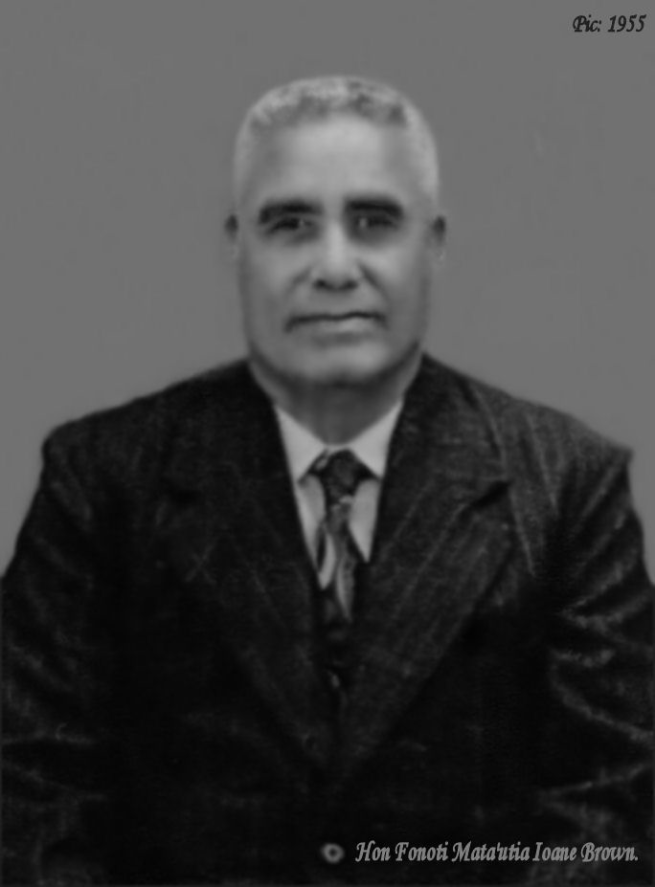 POLITICAL REFERENCE: Hon Fonoti Mata’utia Ioane Brown of Lalovaea and Lotofaga Atua. Born: 1901, Died: 1974. He is a direct descendant of King Fonoti Tupu Tafa’ifa of Samoa. – INFO
POLITICAL REFERENCE: Hon Fonoti Mata’utia Ioane Brown of Lalovaea and Lotofaga Atua. Born: 1901, Died: 1974. He is a direct descendant of King Fonoti Tupu Tafa’ifa of Samoa. – INFO
The First Samoan Successful Businessman, And a Very Successful Politician:
1. The Leader of ‘The Fono of Faipule’ of Samoa from 1939 to 1947.
2. The Leader of the MAU in Atua from 1935 to his last year for the MAU at Vaimoso in 1942.
3. The Chairman for the Public Works Committee from 1948.
4. A Member of the ‘Legislative Assembly’ from 1948 to 1952 and 1955 to 1957.
5. A Member of the ‘Working Committee of the Constitutional Convention of the Government of Samoa 1954 to 1957.
6. The Founder and Leader of The Samoa Democratic Party established in 1951/1953.
7. He was the first appointed joint Directors of the Bank of Western Samoa 1962/1963.
8. A Member of the Copra Board of the Government of Samoa from 1957 to 1972.
9. The Petition for Self-Government in 1944 by Hon Fonoti leader of Fono of Faipule that he presented directly to New Zealand Governor-General Sir Cyral Newall in June, and much more directly to the Prime Minister the Rt. Hon Peter Fraser on the 20-26th of December the same year 1944. The United Nations approval on the 13st December 1946. The newly Samoan flag was raised on the 1st June 1948. Samoa’s Freedom confirmed!
10. A Major Global Recognition of Fonoti of Western Samoa, hes rated at the same level as Gandhi in India and three others for World Peace and Freedom 1945.
From Book: The Evolution of International Human Rights; Visions Seen: Edition2: by Regents Professor Paul Gordon Lauren.
Peace and a Charter with Human Rights: (chapter 6: Page 176)
Thus, many victims in the west began to join with many others like Gandhi in India, Ho Chi Minh of Indochina, Nkrumah and Kenyatta of Africa, Carlos Romulo of the Philippines, and Fonoti of Western Samoa in regarding the right of self-determination as absolutely necessary for International Peace.
The Universal Declaration of Human Rights: (Page 207)
The well-known vocal opponents of colonialism as China, Iraq, Mexico, and the Soviet Union. They battled over the text of each and every trusteeship agreement, trying to drive the specific conditions toward a greater emphasis on the rights of the peoples of these territories. In this regard, they strongly criticized a number of the early draft proposals from the colonial powers, but praised the commitment from the New Zealand that its agreement with Western Samoa would be “In effect a Self-contained Bill of Rights for the Inhabitants.
To view related original documents on Fonoti click on: Documents
(”e ufiufi a le tama’imoa i le tanoa, ae ioio lava..”)
TUMUA MA PULE, ITU’AU MA ALATAUA, AIGA I LE TAI, MA LE VA’A O FONOTI, TAMA MA A LATOU AIGA PO’O AIGA MA A LATOU TAMA.
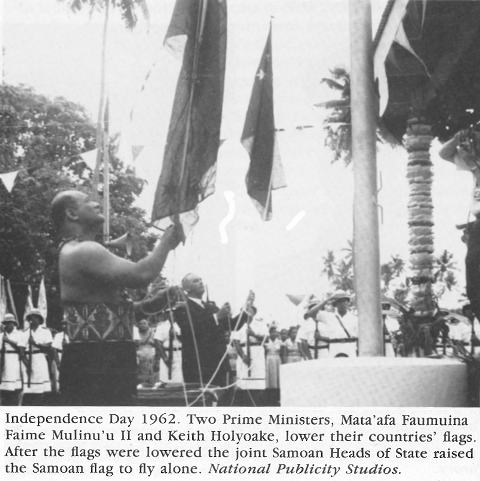




 COPIES MINUTES OF PETITON FOR SELF-GOVERNMENT BY HON FONOTI IN DECEMBER 1944
COPIES MINUTES OF PETITON FOR SELF-GOVERNMENT BY HON FONOTI IN DECEMBER 1944















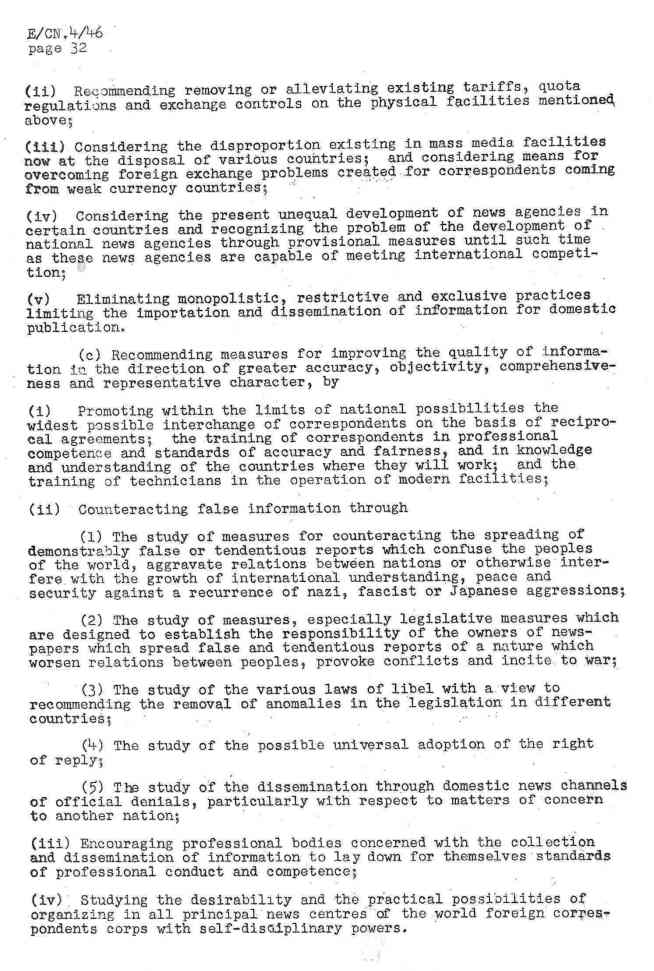







 HON FONOTI MATA’UTIA IOANE BROWN GOVERNMENT APPOINTMENTS OF HIS WISH FOR SAMOA IN 1954 – 1957: SAMOA INDEPENDENCE: ORIGINAL COPIES OF MINUTES TAKEN.
HON FONOTI MATA’UTIA IOANE BROWN GOVERNMENT APPOINTMENTS OF HIS WISH FOR SAMOA IN 1954 – 1957: SAMOA INDEPENDENCE: ORIGINAL COPIES OF MINUTES TAKEN.










 HON FONOTI MATA’UTIA IOANE BROWN. PICTURED IN YEAR 1955
HON FONOTI MATA’UTIA IOANE BROWN. PICTURED IN YEAR 1955










 In 1912, One of the changes, the German administration had apparently achieved its long-term objectives of understanding the traditional forces in Samoa politics, while maintaining a semblance of local participation in government. There was no more TUPU, nor even ALI’I SILI, but the two Fautua were appointed. Tumua and Pule were for a time silenced, all decisions on matters affecting lands and titles were under the control of the Governor. To complete the process, the Fa’alupega for all Samoa was revised. The Fa’alupega which had been nationally accepted from at least the late 19th century (and probably for much longer than that) was as follows:
In 1912, One of the changes, the German administration had apparently achieved its long-term objectives of understanding the traditional forces in Samoa politics, while maintaining a semblance of local participation in government. There was no more TUPU, nor even ALI’I SILI, but the two Fautua were appointed. Tumua and Pule were for a time silenced, all decisions on matters affecting lands and titles were under the control of the Governor. To complete the process, the Fa’alupega for all Samoa was revised. The Fa’alupega which had been nationally accepted from at least the late 19th century (and probably for much longer than that) was as follows:






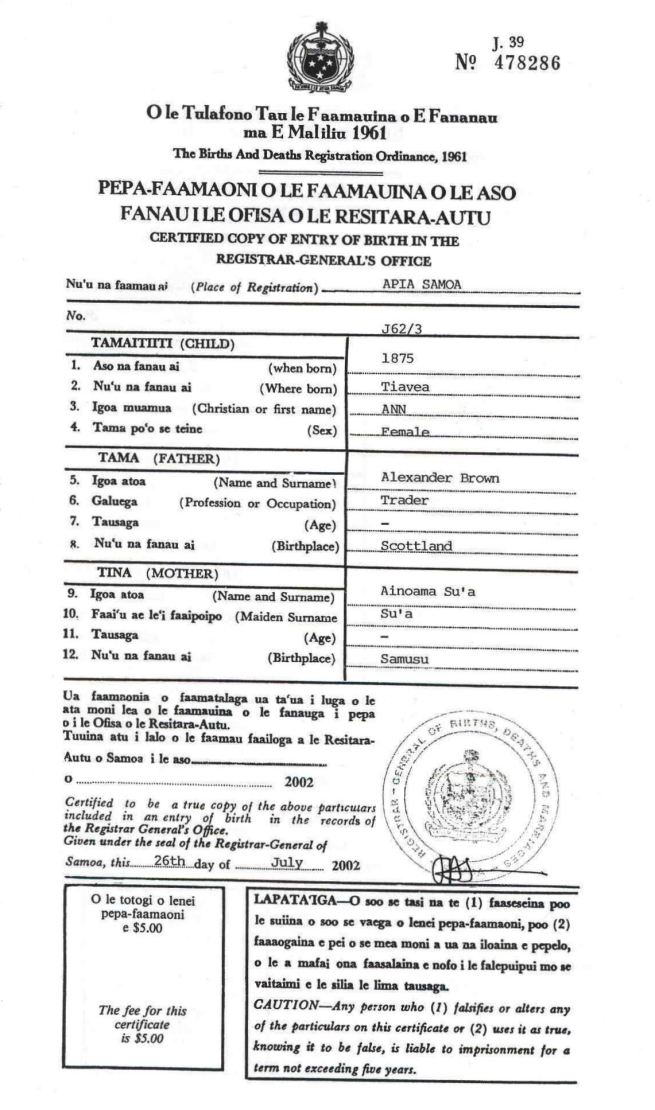

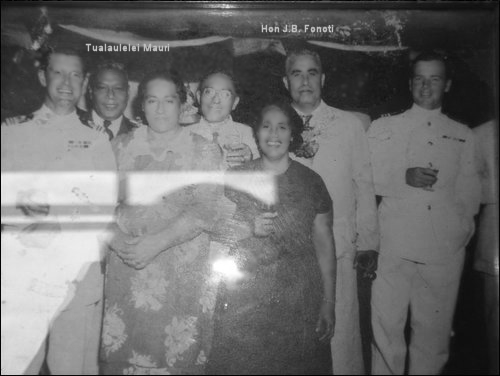









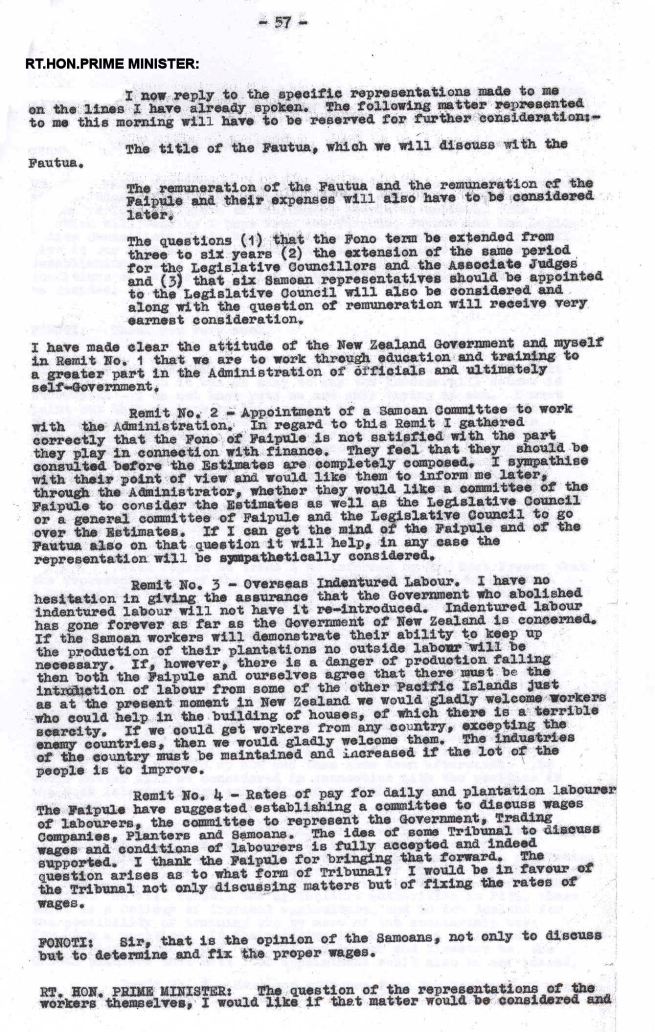


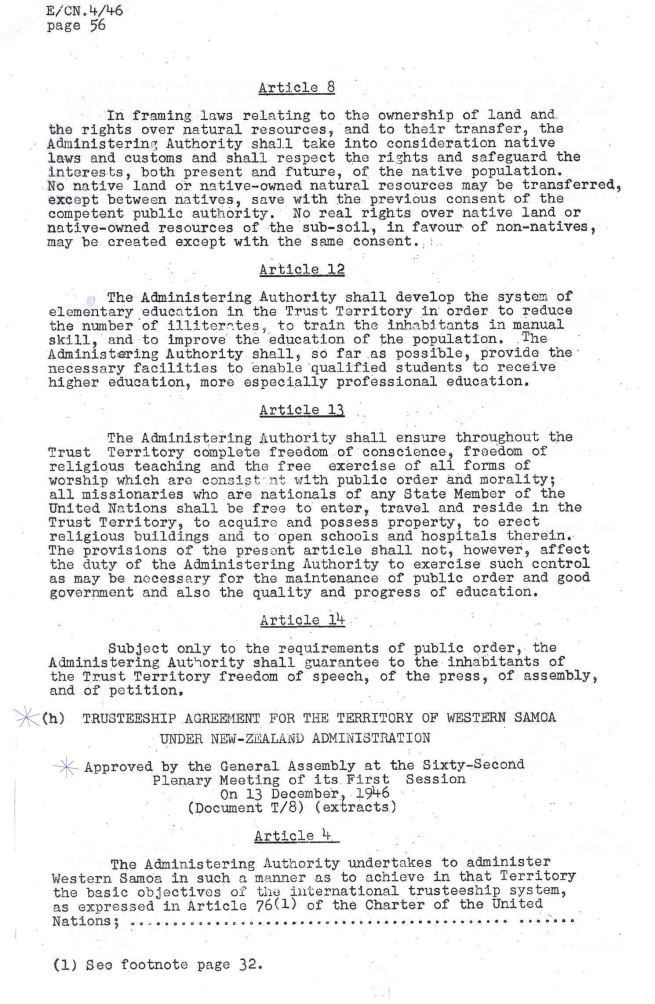

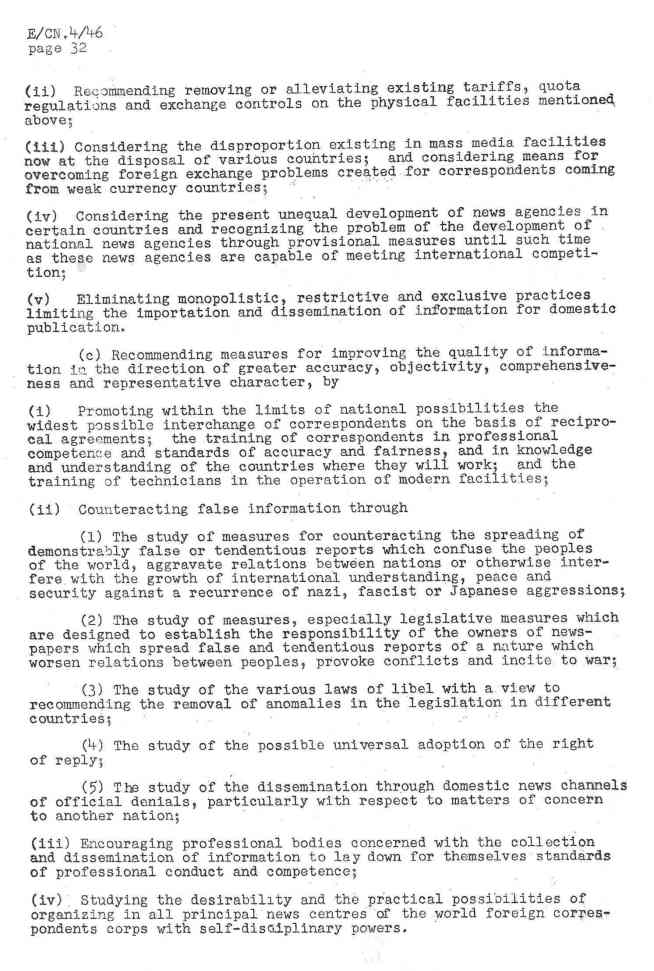



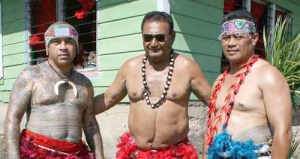










BLOG RECENT COMMENTS